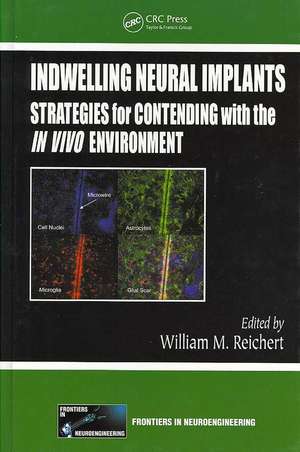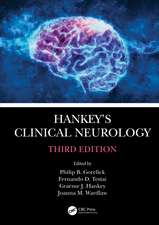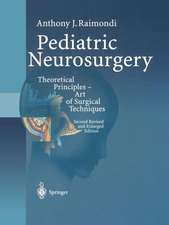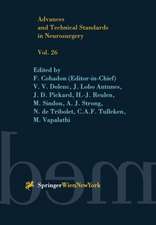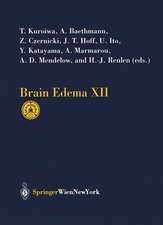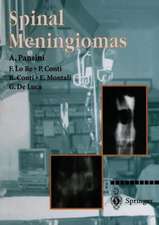Indwelling Neural Implants: Strategies for Contending with the In Vivo Environment
Editat de William M. Reicherten Limba Engleză Hardback – 17 dec 2007
Offering contributions from pioneering researchers in neuroprosthetics and tissue repair, Indwelling Neural Implants: Strategies for Contending with the In Vivo Environment examines many of these challenges, paying particular attention to how the healing of tissues surrounding an implant can impact the intended use of a device. The contributions are divided into four sections
· Part one examines wound healing from the initial insertion trauma through the inflammatory and repair process, explaining how the action of healing varies throughout different areas of the body.
· Part two considers various performance issues specific to particular implant components, including those that arise from the chemical, mechanical, thermal, and electrical impact on surrounding tissues. It discusses challenges that result from chronic tissue stimulation and heat effects that occur with on-chip and telemetric processing.
· Part three presents both in vitro and in vivo approaches to assessing wound healing response to materials. It includes the contribution of the developer of a chronic hollow fiber membrane implant who explains how an in vivo model is used to assess molecular transport in brain tissue surrounding the implant.
· The final section evaluates molecular and materials strategies for intervening in CNS wound repair and enhancing the electrical communication between the electrode surface and the surrounding tissue. It also presents novel approaches to nerve regeneration and repair.
| Toate formatele și edițiile | Preț | Express |
|---|---|---|
| Paperback (1) | 373.63 lei 6-8 săpt. | |
| CRC Press – 23 oct 2019 | 373.63 lei 6-8 săpt. | |
| Hardback (1) | 1044.28 lei 6-8 săpt. | |
| CRC Press – 17 dec 2007 | 1044.28 lei 6-8 săpt. |
Preț: 1044.28 lei
Preț vechi: 1442.94 lei
-28% Nou
Puncte Express: 1566
Preț estimativ în valută:
199.89€ • 217.19$ • 168.01£
199.89€ • 217.19$ • 168.01£
Carte tipărită la comandă
Livrare economică 22 aprilie-06 mai
Preluare comenzi: 021 569.72.76
Specificații
ISBN-13: 9780849393624
ISBN-10: 0849393620
Pagini: 296
Ilustrații: 74 b/w images, 16 color images, 1 table and 99 equations
Dimensiuni: 156 x 234 x 19 mm
Greutate: 0.55 kg
Ediția:1
Editura: CRC Press
Colecția CRC Press
ISBN-10: 0849393620
Pagini: 296
Ilustrații: 74 b/w images, 16 color images, 1 table and 99 equations
Dimensiuni: 156 x 234 x 19 mm
Greutate: 0.55 kg
Ediția:1
Editura: CRC Press
Colecția CRC Press
Public țintă
Academic and Professional ReferenceCuprins
Overview of Wound Healing in Different Tissue Types. Considerations for Chronically Implanted Electrodes for Brain Interfacing. Thermal Considerations for the Design of an Implanted Cortical Brain–Machine Interface. In Vitro Models for Neuroelectrodes: A Paradigm for Studying Tissue–Materials Interactions in the Brain. In Vivo Solute Diffusivity in Brain Tissue Surrounding Indwelling Neural Implants. A Molecular Perspective on Understanding and Modulating the Performance of Chronic Central Nervous System (CNS) Recording Electrodes. Soft, Fuzzy, and Bioactive Conducting Polymers for Improving the Chronic Performance of Neural Prosthetic Devices. Strategies for Regeneration and Repair in the Injured Central Nervous System.
Descriere
A compendium of contributions from noted experts in neuroprosthetics and tissue repair, this book addresses the impact, characterization, and mitigation of the healing of tissues that surround an implant. It describes the differences among wound healing in the CNS, PNS, subcutaneous tissue, and bone. It also examines performance issues of implanted neuroprosthetics arising from the chemical, mechanical, thermal, and electrical impact on surrounding tissue. Contributions present both in vitro and in vivo approaches to assessing wound healing response to materials and describe molecular and materials strategies for intervening in CNS wound repair and enhancing the electrical communication between electrode and surrounding tissue.
